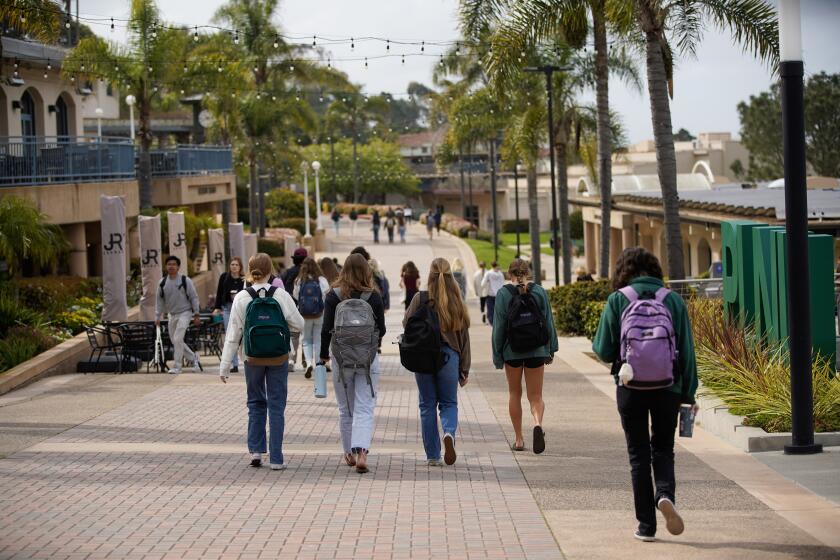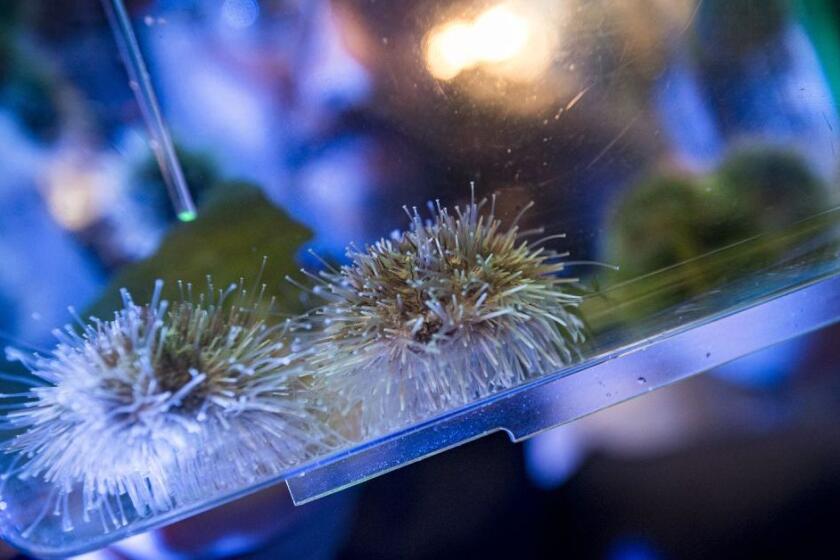Salk celebrates turnaround under Bill Brody
A year later, they’re still talking about it.
William Brody leaned into a piano last August and joined the San Diego Symphony in a soaring rendition of George Gershwin’s “Rhapsody in Blue” during a fundraising concert at the Salk Institute for Biological Studies in La Jolla.
As Salk’s president, Brody’s bona fides in science are well-known. But music? Concert-goers were stunned.
It was a defining moment for Brody, who announced last week that he will retire in December after roughly tripling Salk’s endowment during his six years in office.
“He played without sheet music and did a good job,” said Irwin Jacobs, a Salk trustee and co-founder of San Diego chipmaker Qualcomm. “It showed that he’s multifaceted and able to attract people to the Salk in many ways.”
Other trustees, faculty members and scientists agree that the 71 year-old Brody is a Renaissance man who has done a masterful job of promoting Salk’s mission to everyone, not just funding agencies. He’s brought financial stability and focus to an institute that lacked both when he arrived. He’s positioned the Salk for the future, hiring promising young faculty and broadening the institute’s work in genetics, immunology and the study of the brain.
Through it all, Brody maintained a reputation for fairness, humility and dead-pan humor, even in difficult moments.
“I have a list of the great Americans, and Bill is on it,” said Elias Zerhouni, former director of the National Institutes of Health. “He never misses the human dimension of science.”
Salk’s challenge now is to find a successor who has a similar personality and skill set.
“I’m worried that there’s only five months left before Bill leaves,” said San Diego philanthropist Darlene Marcos Shiley, who recently stepped down after years of service on Salk’s board of trustees. “We need someone who is great in science and someone who can tell the story of the institute. Someone like Bill Brody.”
It’s unlikely that Brody — who helped pioneer the use of magnetic resonance imaging — will extend his presidency. Last year, he had a simultaneous double hip replacement.
“I’m a delight for screeners at the airport,” Brody joked on Friday.
In May, Brody underwent 10 hours of spinal surgery that kept him out of work for weeks.
He has rebounded well. Brody said he’s looking forward to having the time to write a book. Flying also may be in the cards; he’s had a commercial pilot’s license for years.
And he is not feeling a lot of angst about stepping out of the spotlight after serving 12 years as president of Johns Hopkins University in Baltimore and six at Salk.
“I don’t care about the spotlight,” Brody said last week from his sun-splashed office. “I care about making a difference, and I like challenges. I’ve been fortunate to face challenges in every job I’ve had.
“I do wonder what life will be like when I don’t have one. I’m sure I’ll find things to do.”
Despite his distinguished record, there were doubts about whether Brody was the right person for Salk when he left Johns Hopkins, where he had helped raise $3.2 billion during a long capital campaign.
“I was worried that, coming from Johns Hopkins, with probably 30,000 students and hundreds of faculty, he (would) find us way too small and not be excited,” said Inder Verma, a prominent cancer researcher at Salk, which has 50 lead scientists.
“He quickly realized that the demographics of Salk required substantial faculty appointments at the junior and senior level,” Verma added. “He also realized the need for endowed chairs to partially relieve the faculty (of the need) to raise full salaries in the environment of dwindling federal support.”
At the time, the Salk was heading for the shoals financially. The institute had become so reliant on funding from the National Institutes of Health, it hadn’t bothered to cultivate a loyal base of private donors who could help cover dips in government support.
Things began to turn around in 2012 when Brody launched the public phase of a $300 million capital campaign, which is now coming to a successful close. The gifts have included $42 million from the Helmsley Charitable Trust in New York and $25 million from San Diego philanthropist Conrad Prebys.
“It’s like Bill can see around curves,” said Zerhouni, who was NIH director from 2002-08 and now heads research for the pharmaceutical giant Sanofi. “He predicted that there could be bad times ahead for biomedical institutions because of the overall budget picture, and he acted on it.”
Brody courted potential donors and contractors, who were willing to listen to his appeal.
“He created new revenue streams by going to foundations and pharmaceutical companies, something that he was able to do because he understands the culture of the institute,” said Greg Lemke, a Salk geneticist and trustee. “He wasn’t just reading talking points. He is part of us.”
Brody’s take on his own contribution is more understated: “At the Salk, we don’t have alumni or grateful patients. So raising money really is about making connections, making ties to things people care about.”
His connections span science and medicine. Brody is a “mudphud” — someone who earns both a medical degree and a doctorate. Brody received his degrees at Stanford University in the early 1970s, where he combined his interests in medicine and electrical engineering. Before long, Brody was doing pioneering work in the emerging field of bioengineering, focusing on MRI technology.
He founded Resonex, a Bay Area company that developed an “open” MRI, an alternative to the tunnel-shaped machines that limited physician’s access to patients. The tunnels also caused many people to become claustrophobic.
“Everyone told us that it would not work,” said Brody, who grew up in Stockton, the son of an ophthalmologist.
Resonex soon lost its chief executive, leading investors to press Brody to take full control of the company even though he had little business experience.
That was when Brody learned the art of asking for money.
He raised about $25 million from venture capitalists, enabling him to build an MRI machine that was purchased by Johns Hopkins, the nation’s largest research school. The university also ended up making Brody chief of radiology, where he mentored Zerhouni, then a young scientist who found ways to more broadly use MRI in medicine.
“Bill taught me that you can’t become a complete scientist unless you look beyond your own specialty,” Zerhouni said. “Don’t respect barriers, don’t worry about consequences or tradition. He transformed the culture at Johns Hopkins. I would not have become director of NIH if it wasn’t for Bill.”
Brody left Hopkins in 1994 for an executive position at the University of Minnesota. Barely two years later, he was asked to return as president, when Hopkins was mired in financial and political turmoil.
It was a messy scene that he recalls in a matter-of-fact way: “The trustees decided to change the governance and bring (Hopkins’) medical school and hospital together,” Brody said. “It worked amazingly well. Along the way, we shored up Hopkins’ finances.”
His fundraising prowess appealed to recruiters at the Salk, whose endowment then stood at only $130 million. Today, it is $370 million.
“It was kind of a long courtship,” said Brody, who never met the institute’s namesake, polio vaccine developer Jonas Salk. “I am not a molecular biologist, and I didn’t know if the faculty would be open to someone from a different field. But the more I talked to faculty, the more I became convinced that they were open to someone from a different discipline — in part because I would not tell them how to do good science.
“They would try to tell me how to run the institute, but that is true everywhere.”
Brody stood out to Shiley not just because of science, but also his devotion to the arts.
“Jonas Salk loved the arts and Bill has made sure that we’re still involved,” Shiley said, referring to events like Symphony at Salk, an annual fundraising event held each August. That’s where Brody played Gershwin last year.
The moment lingers in his mind:
“The sensation of sitting on the stage and listening to the clarinet play the opening notes and then hearing the entire orchestra join in doesn’t get any better than that. I wanted to pinch myself to see if the experience was really happening, but I was too scared to take my hands off the keyboard.”






